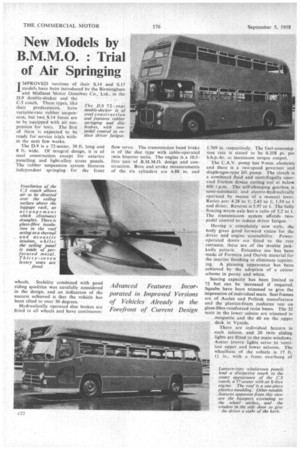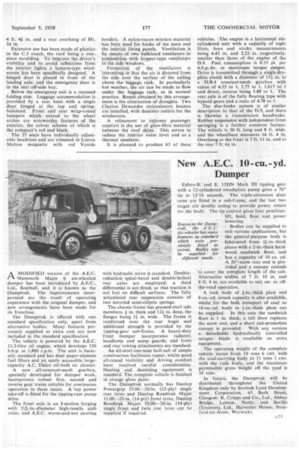New Models by B.M.M.O. : Trial of Air Springing
Page 60

Page 61

If you've noticed an error in this article please click here to report it so we can fix it.
MPROVED versions of their S.14 and S.15 models have been introduced by the Birmingham
and Midland Motor Omnibus Co., Ltd., in the D.9 double-decker and the C.5 coach. These types, like their predecessors, have variable-rate rubber suspension, but two 5.14 buses are to be equipped with air suspenSion for tests. The first of these. is expected to be ready for service trials within the next few weeks.
The D.9 is a 72-seater, 30 ft. long and 8 ft. wide. Of integral design, it is of steel construction except for exterior panelling and light-alloy stress panels. The rubber suspension system features independent springing for the front wheels. Stability combined with good riding qualities was carefully considered in the design, and an indication of the success achieved is that the vehicle has been tilted to over 30 degrees.
Hydraulically operated djsc brakes are fitted to all wheels and have continuous
flow servo. The transmission hand brake is of the disc type with cable-operated twin bisector units. The engine is.a 10.5litre unitof B.M.M.O. design and construction. Bore and stroke measurements of the six cylinders are 4.88 in. and 5,709 in. respectively. The fuel-consumption rate is stated to be 0.358 pt. •per b.h.p.-hr. at maximum torque output.
The C.A.V. pump has 9-mm. elements and there is a two-speed governor and diaphragm-type lift pump. The clutch is a combined fluid and centrifugally operated friction device cutting out at below 800 r.p.m. The self-changing gearbox is seini-automatic and electro-hydraulically operated by means of a manual lever. Ratios are: 4.28 to .1; 2.43 to 1; 1.59 to 1 and direct. Reverse is 5.97 to 1. The fully floating worm axle has a ratio of 5.2 to 1. The transmission system attords twopedal control to reduce driver fatigue.
Having a completely new style, the body gives good forward vision for the driver and engine accessibility. Poweroperated doorsare fitted to• the rear entrance, these are Of the double jackknife pattern. Extensive use has been made of Formica and Darvic material for the interior finishing to eliminate repainting. A pleasing appearance has been achieved by the adoption of a colour scheme in peony and white.
Seating capacity has been limited to 72 but can be increased if required. Squabs have been trimmed to give the impression of individual seats. Seat frames are of Accles and Pollock manufacture and the plastics-foam cushions rest on glass-fibre-reinforced resin bases. The 32 seats in the lower saloon are trimmed in moquette and the 40 on the .upper deck. in Vynide.
There are individual heaters in each saloon, and 20 twin sliding lights are fitted to the main windows. Auster louvre lights serve to ventilate upper and lower saloons. The wheelbase of the vehicle is 17 ft. 11 in., with a front overhang of 4 ft. 4-1 in. and a rear overhang of 811. 31 in.
Extensive use has been made of plastics in the C.5 coach, the roof being a onepiece moulding. To improve the driver's visibility and to avoid reflections from the interior_ lights, .a Ian tern-type windscreen has been specifically designed. A hinged dour is placed in front of the leading axle, and the emergency door is in the rear off-side bay.
. Below the emergency exit is a recessed folding step. Luggage accommodation is provided by a rear boot with a single door . hinged at the top and springbalanced. Front and rear wrap-round bumpers which extend to the wheel arches are noteworthy features of the exterior, the colour scheme of which is the company's red and black.
The 37 seats have 'individually adjustable headrests and are trimmed in Linton Mallon moquette with red Vynide borders. A nylon-rayon mixture material has been used for backs of the seats and the interior lining panels. Ventilation is by means of two bulkhead ventilators in conjunction with hopper-type ventilators in the Side 'windows.
ForrnatiOn. of the ventilators is interesting in that the air is directed from the side over the surface of the ceiling above the luggage rack. In particularly hot weather, the air can he made to flow under the luggage rack, as. in normal practice. Result Obtained by this arrangement is the elimination of draughts. Two Clayton Dewandre recireulatory heaters are installed, with demister outlets for the windscreen.
A refinement to enhance passenger comfort is the use of .glass-fibre material between the ioof skins. This serves to reduce the interior noise level and as a thermal insulator.
It is planned to produce 65 of these vehicles. The engine is a horizontal sixcylinclered unit with a capacity of eight litres, bore and stroke measurements being 4.45 in. and 5.25 in. respectively, smaller than those of the engine of the D.9. Fuel consumption is 0.35 pt. per b.h.p.-hr, at maximum torque output. Drive is transmitted through a single-dryplate clutch with a diameter of 151 in. to D.13.4 constant-mesh gearbox with ratios of 4.55 to 1, 2.75 to I, 1.617 to 1 and direct, reverse being 5.88 to 1. The rear axle is of. the fully floating type with hypoid gears and a ratio of 4.78 to 1.
The disc-brake system is of similar description to that of the D.9, and there is likewise •a transmission handbrake. Rubber suspension with independent front springing is a' further common feature. The vehicle is 30 ft. long and 8 ft. wide, and the wheelbase measures 16 ft. 4 in. Overhang at the front is 5'f1. II in. and at the rear 7 ft. 61 in.




































































































